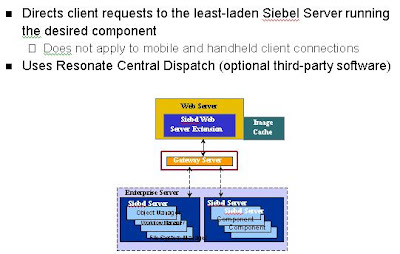Click On the Image to get Clear view
Siebel Web Architecture Overview
Browser Access
Client browser access might be different depending on client deployment.
Differences in the Siebel clients will be explored in the next module.
Siebel Clients WML
WML WML (Wireless Markup Language) is intended for use with narrowband
devices, including cellular phones and pagers.
Web Server and Siebel Web Server Extension
 Stateless Connection
Stateless ConnectionThe Siebel Web Server Extension connection to the Object Manager is
stateless. This allows sessions to be dynamically load balanced across
Web servers at the HTTP request level. It also improves Web server
Image Cache
 Gateway Server: Name Server
Gateway Server: Name Server
The Gateway Server
The Gateway Server runs as a Windows service or UNIX daemon
Clustered Environment
The Gateway Server can be run in a clustered environment to provide
Gateway Server: Connection Brokering
 Exceptions
ExceptionsMobile and handheld Web clients connect directly to the Siebel Server.
These clients are covered in more detail in the next module.
Load Balancing
To enable optional load balancing, Resonate must be installed.
Siebel Server



Data Manager
 Performance
PerformanceThe Data Manager uses optimal database-specific queries to enhance
performance:
• Uses database-specific client access libraries for the best
performance
• Takes advantage of database-specific functionality
• Optimized to return only fields necessary for a specific request and
Database Server
 Siebel Web Engine
Siebel Web Engine
Markup Languages
Hypertext Markup Language (HTML), Wireless Markup Language (WML),
and Extensible Markup Language (XML) are used to define content and
Siebel File System

Web Usage Scenario
 Overview: Logical Server Architecture
Overview: Logical Server Architecture Physical Architecture
Physical Architecture

